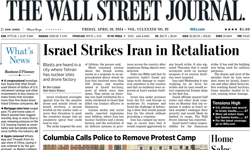Several years ago, it was publishers that were among the first organisations to realise that delivering content to peoples’ mobile telephones was likely to become more significant as time went on. A number of the key UK players were early adopters in the space.
The immediacy of mobile meant that users could access content when and wherever they wished, but a mobile website was quickly nudged aside by a slicker, more sophisticated beast, a smartphone app.
The next phase involved the transference of this content delivery onto tablet devices, and the inevitable learning curve that came with adapting a service to a similar looking yet altogether different device, with new capabilities and increased opportunities for interaction.
Most of the serious newspapers now produce an iPad app. “The point is that it’s driven by consumer behaviour,” says David Murphy, editorial director at Mobile Marketing Magazine. “People are voting with their feet, or voting with their finger.
“If they go to a website on their phone and it’s not optimised for mobile, you have to pinch and zoom in order to read the content, it’s not a nice experience; and you risk losing those people to a rival who does it better.”
The race is on for content creators, publishers, news organisations and everyone in between to meet the ever changing needs of their audiences. Olivier Legrand, General Manager, for the Wall Street Journal Digital Network in Asia Pacific, where apps are currently exploding, says his team has stayed ahead of the curve by ensuring that the newest techniques are implemented quickly.
WSJ has rapidly expanded its digital and online teams, including adding web designers, UI architects and mobile product managers, and the firm already has more than a million downloads of its Asia news app under its belt. “You need to take technology seriously and invest in the necessary tools and resources to stay ahead,” he says.
However, Legrand says getting these tools into the hands of the editorial staff is crucial in order to drive engagement. “This has become a serious effort for the Journal's editorial team, evidenced by our popular Real Time blogs online in Asia and newly launched Asia Today video reports.”
But what are these apps? What do they deliver? Well, there a number of different publishers using them in different ways. You might expect an iPad version of a paper to be about as all singing and all dancing as it gets. But some publishers would argue that if you want the news constantly updated through round the clock feeds, then they’ve got a website for that.
These apps are viewed almost like a digest of what the editorial team thinks are the most important items in the paper that was printed at nine o’clock that morning. Go back and check the iPad version at ten o’clock at night, it’ll still be what you saw that morning.
Then you’ve got apps like the Guardian news app, which includes everything you would find on the paper’s website, unabridged. The key is the navigation experience. “You’d be mad not to try and leverage some of the capabilities of the tablet and mobile devices,” says David Murphy. “Our designer is always asking us for interactive content, if there’s any video content we can supply to link to from the app.
“One story I saw recently had a photo gallery of about 25-30 photographs, making great use of the big colour tablet screen. You can’t do that in a print edition, you just don’t have the room to include 30 images.”
But this business isn’t about charity. These new channels are sophisticated and exciting, but they still have to pay for themselves. Some publishers, on their first iteration, began by charging a one-time fee for their app. However, they soon realised that once you’ve charged that one-time fee, you might get 200,000 downloads, but once they’re done, they’re done.
The way it seems to be moving currently, particularly among newspapers, is towards the subscription model. You get 30 days for £10, for instance, or subscribe for a year for a bit more. Whereas in other cases, an app is actually used as a value add to the physical newspaper. So if you take out a year’s subscription to the newspaper, you get the iPad version thrown in for free.
Expensive? Yes, these apps can be furiously expensive to develop; but do not despair. There are a number of very highly rated do-it-yourself app developer services that come in free-of-charge or with minimal cost in the first phase. Services like WoodWing, the tablet specialist, or Rippll which provides a build-your-own-app service, can be the key for publishers just starting out in the space.
To learn more about the opportunities mobile and tablet apps can provide for publishers, visit Apps World Europe 2011, at Olympia on 29-30 November. David Murphy will be joined by experts representing a number of successful UK publishers including the Guardian, Dennis publishing, BSkyB, the Mail Online, Future Publishing and IPC, to discuss the threats and challenges.










